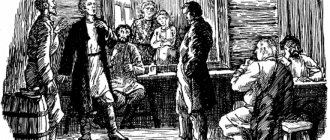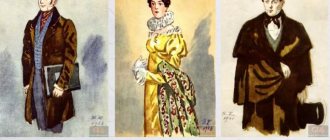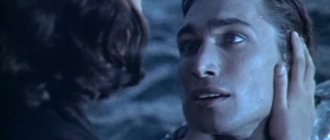"Bleak House" summary
"Bleak House" Dickens summary
Esther Summerson spends her childhood in Windsor, in the house of her godmother, Miss Barbery. The girl feels lonely and wants to find out the secret of her origin. One day Miss Barbery can’t stand it and says sternly: “Your mother has covered herself with shame, and you have brought shame on her. Forget about her...” A few years later, the godmother suddenly dies and Hester learns from the attorney lawyer Kenge, representing a certain Mr. John Jarndyce, that she is an illegitimate child; he declares, in accordance with the law: “Miss Barbery was your only relative (illegal, of course; by law, I must note, you have no relatives).” After the funeral, Kenge, aware of her lonely situation, offers her study at a boarding house in Reading, where she will not need anything and will prepare to “fulfill her duty in the public field.” The girl gratefully accepts the offer. “The six happiest years of her life” pass there.
After completing her studies, John Jarndyce (who became her guardian) assigns the girl as a companion to his cousin Ada Claire. Together with Ada's young relative Richard Carston, they go to an estate called Bleak House. The house once belonged to Mr. Jarndyce's great-uncle Tom Jarndyce, who shot himself after being unable to withstand the stress of the Jarndyce vs. Jarndyce inheritance battle. Red tape and abuses by officials led to the process lasting for several decades; the original plaintiffs, witnesses, and lawyers had already died, and dozens of bags of documents related to the case had accumulated. “It seemed as if the house had taken a bullet in the forehead, just like its desperate owner.” But thanks to the efforts of John Jarndyce, the house looks better, and with the arrival of young people it comes to life. The smart and sensible Esther is given the keys to the rooms and storage rooms. She copes well with household chores - it’s not for nothing that John affectionately calls her Troublemaker
.
Their neighbors turn out to be Baronet Sir Leicester Dedlock (pompous and stupid) and his wife Honoria Dedlock (beautiful and arrogantly cold), who is 20 years younger than him. The secular chronicle notes her every step, every event in her life. Sir Leicester is extremely proud of his aristocratic family and cares only about the purity of his good name.
A young employee of Kenja's office, William Guppy, falls in love with Esther at first sight. While on company business at the Dedlock estate, he is struck by her resemblance to Lady Dedlock. Soon Guppy arrives at Bleak House and confesses his love to Esther, but receives a decisive refusal. Then he hints at the amazing similarity between Hester and the lady. “Honour me with your hand, and I can’t think of anything to protect your interests and make you happy! I can’t find out anything about you!” He kept his word. Letters from an unknown gentleman who died from an excessive dose of opium in a dirty, squalid closet and was buried in a common grave in a cemetery for the poor fall into his hands. From these letters, Guppy learns about the connection between Captain Hawdon (this man) and Lady Dedlock, about the birth of their daughter. William immediately shares his discovery with Lady Dedlock, which causes her extreme confusion.
You might be interested in:
- Peaky Blinders interesting facts
- Industrial equipment: what is more profitable - rent or...
- Secrets of guaranteed destruction of ants at home and...
- Hair transplant: myths and reality
Endless judgment. Charles Dickens. Bleak House
Charles Dickens was the leader of English and English-language prose in general of his time. This is a major author who left a gigantic legacy. He can be attributed to the direction of critical realism, although sometimes his work retains bright romantic features. The voluminous novel “Bleak House” was written by him at the age of forty. It is not often ranked among his most famous works, but nevertheless it is very interesting due to its unusual content. The fact is that one of the themes of this book - the false metaphysical essence of judging - anticipates Kafka's "The Trial". This allows you to create a powerful realistic intensity, although the metaphysical aspects of Kafka's legal proceedings were much more pronounced.
Like any large-scale work, Bleak House addresses a number of themes and subplots. If we try to highlight the main themes in this gigantic book, then these will be: the mercantile nature of jurisprudence, which in reality does not want to help a person, but to squeeze all the juice out of him; the pressure of aristocratic rules that can actually destroy a person with an insufficiently “pure” past; the dire economic situation of the lower strata of society against the backdrop of industrial development; total idle talk and mannerisms of people; the disastrous bondage of usury; the vain faith of youth in justice. Let's look at these topics in more detail. Lawyers, advocates, attorneys and judges embody something demonic in the book. The plot revolves around certain wills of a certain Jarndyce, which contradict one another and do not allow identifying those to whom the inheritance should be transferred. The case has been dragging on for decades, with no progress. Because of this litigation, everyone quarreled with everyone else. And this is only to the advantage of lawyers, because their goal is precisely for the entire inheritance to go towards paying legal costs. In the novel we read: “The most important principle of the English judicial system is to create litigation for the sake of litigation for its own benefit.” The litigants would be glad to stop the litigation, but they cannot; they are obliged to act as opposing parties in court. It gets to the point that some are already beginning to sincerely believe that all judges, along with the court, should simply be destroyed. In general, judicial realities resemble the devil's kitchen. One half-crazed old woman named Mrs. Flyte sees the seal of Satan in the judge's seal. However, the court is devilishly attractive for her. Her madness is the door to a fundamental sense of the court as something transcendental, which again connects the “judicial” part of the book with the work of Kafka. The court, like Kafka, cannot be influenced. His decisions can only be followed and cannot be avoided. And it simultaneously repels and attracts. Old lady Flight specifically chooses her place of residence so that she can look at the courthouse at night. The court embodies the absolutely irrational arbitrariness of completely earthly forces, as if they were really directed by the devil himself, not allowing them to advance on the merits and forcing them only to confuse the circumstances of the case for their clients. The trial is endless tricks and revisions, rummaging through old papers and writing new ones, searching for arguments and evidence that, however, do not change anything. In general, everything is like Kafka. Only in Dickens it is not the person who suffers from the trial, but his money.
Another theme is the purity of the past. The elderly baronet Dedlock is married to a woman younger than himself, but over time it turns out that she had an affair and a child in the distant past. The child seemed to have died in infancy, and Lady Dedlock abandoned him. However, this child survived and was raised by his mother’s sister, and over time turned into the girl Esther Summerson, positive in all respects. Some careless letters are discovered, and now a ring is tightening around Lady Dedlock. If her early affair came to light, it would be a disgrace for the baronet's family. In the end, everything becomes known to him, but he forgives his wife and pays off those who also read the letters. However, for Lady Dedlock everything ends sadly - the burden of the past is too heavy to lift. These days, of course, this story comes as no shock to anyone. Stars, celebrities and aristocrats today have five marriages each, but in Dickens's time aristocracy took on very severe forms. Which is what the writer himself is ironic about. Sir Dedlock is the unfortunate embodiment of conservatism, afraid of the slightest change. He is terrified of a repeat of Wat Tyler's rebellion. He considers it necessary to suppress any indignation of the people with an iron hand, and with working people, even prominent and rich ones, he tries to keep his distance. And this man, who treats those lower in rank as cattle, hypocritically calling it order, for some reason is very worried when he finds out about his wife’s past. In general, Dedlock is definitely not in Dickens' favor.
The industrial realities of London and its environs are also not encouraging. Previously, there was just fog on the streets, but now, after the industrial revolution, high chimneys release black smoke into the sky. However, this does not affect social well-being in any way. It is known that social policy is an invention of the twentieth century. In the meantime, a teenage girl can work day and night as a laundress to feed her younger brothers and sisters. And a boy named Joe naturally dies of hunger. Meanwhile, the local policeman, regretting that he cannot be arrested, strongly recommends that he not linger in one place, that is, continue to wander, but so that he will not be seen. In short, the situation of ordinary people is very unenviable. The fate of those who had the misfortune of falling into the clutches of moneylenders is especially sad. Such is the soldier George, who took the sum from the decrepit old disabled man Smallweed, who, however, did not lose the skill of quickly counting money. The scenes of the meeting between the simple soldier George and the greedy old moneylender are full of hatred. George's money (he runs a shooting range and teaches army skills) is only enough to cover the interest. That is, he is an eternal debtor with no prospect of ever repaying the full amount. And the nasty old man does not forget to threaten that he needs all the money back!
In part, Dickens's novel also reads like a gallery of caricatured characters engaged in idle talk. Reading a book is like flipping through an album of reproductions. Here is a clerk hopelessly asking for a girl's hand in marriage, here is a stationery dealer married to a woman obsessively watching her figure. Here is a man who endlessly reads sermons that are as empty as those who greedily listen to them. All these people are united by a pathological inability to do real work. People's characters are a function of their facial features and build, that is, they are partly cartoons, caricatures that never change. The book depicts people whose meaning in life is only to demonstrate good manners without working; there are also those who simply pathologically admire others for even the smallest merits. The more deeply written characters are fiercely polarized. There are absolutely evil ones (loan sharks, attorneys), whom Dickens does not even try to understand and justify; there are infinitely positive and beautiful ones (Esther Summerson, guardian). There are also those who take the path of error because of their youth.
“Bleak House” is, of course, a realistic work, not devoid of accusatory pathos and sad observations of the situation of ordinary people. There are many descriptions of pure feelings, but there is also room for the stench, dirt and stinking puddles on the streets of London. This book is not so much about the confrontation between good and evil, but more abstract light and darkness. The legal battle eventually ends, although to no avail, but the energy of wonderful people continues to illuminate the world.
Sergey Sirotin
Popular retellings today
- Kamo is coming - a summary of the novel by Sienkiewicz
Work on the novel, the first episode of which was published on March 26, 1895, was extremely grueling for Sienkiewicz. During eleven months of intensive writing, he lived as if in a trance - Summary of the novel The Phantom of the Opera by Gaston Leroux
The adventure novel “The Phantom of the Opera,” written in the Gothic style, was first published by the French author Gaston Leroux during 1909-1910. At the center of the plot of the work is - Summary of the story It's Hard to Be a God by the Strugatskys
In terms of genre, the work belongs to a science fiction story, the main theme of which is the impossibility of change and intervention in historical development. - The story of Lieutenant Ergunov - a summary of Turgenev's story
The main character of the story, Kuzma Vasilyevich Ergunov. He is a lieutenant, his department includes naval buildings in Nikolaev. For various needs, his superiors regularly give him a large sum of money.




